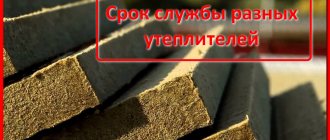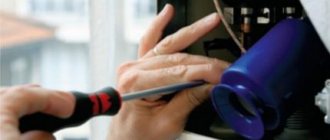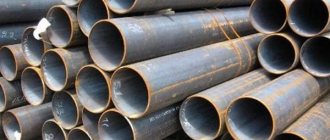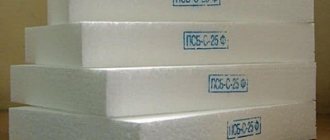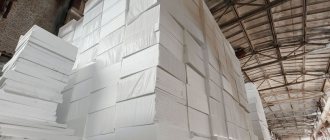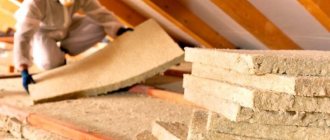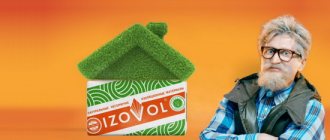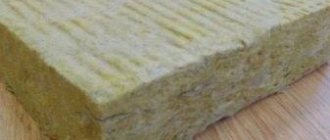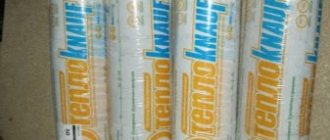One of the universal thermal insulation materials can be called polystyrene foam, which is used for various types of work.
Some people mistakenly consider it short-lived and harmful, but in reality everything turns out to be completely wrong. The service life of polystyrene foam is influenced by various parameters, but their impact is not nearly as detrimental as is commonly believed. Foam boards have the necessary rigidity, resistance to moisture, temperature, and corrosion. They are not susceptible to rotting, which is so important when insulating wooden surfaces. The only downside that should be noted is the fragility of the material. During operation, care should be taken not to damage the slabs. This circumstance cannot prove the fact that the service life of foam plastic is short. Insulating walls with foam plastic will protect them from moisture, cold and corrosion for a long time.
Polystyrene foam
There is pressed and non-pressed foam; it is not too difficult to distinguish them, even if you are not a professional. If you have ever looked at the structure of a material, you have most likely noticed that it consists of small balls that are interconnected, like a honeycomb in a beehive.
Pressless foam can be seen in boxes with household appliances, as it is actively used for packaging.
In terms of thermal insulation properties and appearance, the pressed one is practically no different from the second one; its granules adhere to each other somewhat more firmly, due to which it does not crumble. At the same time, pressed foam is more difficult to produce, which means it is more expensive, which is why it is less widespread.
What affects the service life of insulation?
As with everything, it is believed that the service life of insulation depends on its cost and quality. Manufacturers of the inexpensive substance claim that it can last at least 50 years. In practice, this figure is not confirmed by anything, so in the footnotes they write that today there is no standard operating time for insulation materials.
In addition, what the material is made of is important. Experts confirm that man-made fibers cannot provide a warranty of more than 35 years. During this time they dry out and collapse. But the most important thing is that they lose half of their heat-saving properties. While natural fibers do not lose their original qualities and can last for a longer period.
According to regulatory guidelines, every home must undergo an energy audit upon completion. Such checks should be carried out every 25 years so that the current level of heat-saving properties can be assessed. But since we are unable to find out the exact numbers due to verification, we use data that comes to us from Europe.
Polystyrene foam characteristics:
- biological and chemical resistance to sea water, alkali, salt, soap, cement, bitumen, lime, gypsum;
- low thermal conductivity;
- resistance to temperature changes, due to which the material can be used in different climatic conditions;
- it is not a favorable environment for the development of fungi, mold and microorganisms;
- high vapor permeability - thanks to it, the moisture that accumulates in the walls evaporates;
- excellent soundproofing properties.
Fire resistance
Being a combustible material, polystyrene foam has good fire resistance, since the spontaneous combustion temperature is +4910 C. This indicator is 1.8 times higher than that of wood, for which +2600 C is enough. In the absence of fire within 4 seconds, the combustion dies out. During combustion, the material releases about 1000 MJ/m3 of energy, while wood - 7000-8000 MJ/m3 - which means that when burning polystyrene foam, the temperature increase will be much lower.
Manufacturers offer self-extinguishing polystyrene foam made with the addition of fire retardants. However, experiments show that the self-extinguishing effect is lost over time, and in the design the material, which was initially classified as belonging to the G2 flammability group, after some time already corresponds only to the G4 class (research carried out at the Research Institute of Industrial Safety and Emergency Situations of the Ministry of Emergency Situations of Belarus).
At the same time, it should be recognized that the products released during the combustion of different brands of polystyrene foam are still poorly studied.
Basic properties of polystyrene foam as insulation
Expanded polystyrene is popularly called “foam plastic”. This word comes from the name of a Finnish company that supplied expanded polystyrene to the USSR. The name of the company was transformed over time into the name of this material.
At the moment, foam plastic is produced abroad and in Russia by various companies. The equipment for its production is cheap, and does not require skilled labor for maintenance and operation.
Now let's look at the properties of polystyrene foam:
- This is a flammable material. If we consider the disadvantages of polystyrene foam as insulation, then this property can be identified as the main one. This has a negative impact on the use of polystyrene foam. This especially applies to its use in ventilated facades. In a place where there is free access of air to the insulation, polystyrene foam cannot be used.
- It's light. This characteristic of polystyrene foam as insulation allows it to be used for heating various lightweight structures. Foam plastic does not increase the weight of structures, which puts it in first place among insulation materials when it is necessary to maintain the same weight of the structure or avoid overloading it.
- Mice eat it. Rodents love to make nests in thick foam. It is necessary to cover the foam with a fine metal mesh to prevent such an incident.
- It's warm. Its thermal insulation properties are actually excellent, the thermal conductivity is 0.03-0.05 W (m*C). Due to this, polystyrene foam is often used as insulation; reviews about it say that it is a reliable and inexpensive material.
- Polystyrene foam is cheap, which gives it a big head start over other effective insulation materials.
- This material perfectly absorbs moisture, which does not allow it to be used for insulating pipes that are located in the ground.
Now let's move on to the use of polystyrene foam in low-rise private construction.
conclusions
We examined the key features of expanded polystyrene as insulation from a safety point of view. Now, so that you can make an informed choice, let’s compare its main characteristics with stone wool.
- The flammability group of polystyrene foam is G3-G4.
- The flammability group of stone wool is NG - non-combustible material.
- The thermal conductivity coefficient of polystyrene foam (depending on density) is 0.035 - 0.043 W/(m °C).
- The thermal conductivity coefficient of stone wool at, and this is important, normal humidity and material density of 40-80 kg/m³, = 0.041 - 0.042 W/(m °C). If the “cotton wool” gets wet, then its heat-insulating properties deteriorate.
- When installing polystyrene foam, the installation of vapor barrier and wind protection is not required. When installing mineral wool insulation, you need to install a vapor barrier inside the room, and a diffusion vapor-permeable membrane outside, which will protect the insulation from atmospheric moisture. This is an additional expense + the need for careful gluing of joints and overlaps of films to create a sealed contour.
- The vapor permeability of PSB-S-25 foam is 0.05 mg/(m•h•Pa), and of stone wool (depending on the density and manufacturer) 0.3 – 0.55 mg/(m•h•Pa). That is, expanded polystyrene is a material with limited vapor permeability and, according to this indicator, it is definitely inferior to mineral wool. From here, as many believe, the house will not “breathe.” Let’s leave the mythical “breathing of walls” outside the scope of this article. Just compare the numbers:
- The vapor permeability of pine along the fibers 0.32 mg/(m•h•Pa).
- The vapor permeability of pine across the fibers is only 0.06 mg/(m•h•Pa).
Installation nuances . The foam in the slabs will have to be cut and precisely adjusted to the size between the posts. This will increase the complexity and time of work. Stone wool measuring 120x60 cm is placed in front. It's simpler, faster and easier for builders.
And, in conclusion, recommendations - if you want to insulate a frame house with polystyrene foam, installing it between the studs, choose high-quality material from trusted manufacturers with fire retardants and a density of at least 20 - 25 kg/m³. Beware of noname fakes! From the inside of the building, polystyrene foam must be covered with non-flammable or low-flammable materials that do not ignite and do not spread flame, for example, gypsum fiber boards or DSP. It is better to avoid insulating the roof with foam plastic between the rafters or attic , because... Roofing coverings, such as metal tiles or corrugated sheets, become very hot in the summer heat. Elevated temperatures lead to the release of harmful volatile substances from the foam, which will negatively affect the polystyrene foam and can, over time, lead to degradation of the material. It is prohibited to use expanded polystyrene for insulation of suspended ventilated facades . If polystyrene foam is glued outside the frame walls onto OSB sheets, it must be covered with a layer of plaster, i.e. a “wet façade” is installed.
- Aspiration of stone wool - bulk insulation in the form of crumbs is 3 times cheaper than mineral wool in slabs - myth or reality?
- 3 main mistakes when installing wind protection and diffusion membranes in wooden and frame houses.
- 4 electric thermal cutters for cutting foam plastic and extruded polystyrene foam with nichrome string - do it yourself for 3 kopecks.
In the video - how to cheaply insulate a frame: a master class on installing mineral wool.
Internal insulation of the room
This method is less common than the previous one, although it is also effective. It is very convenient that it can be implemented regardless of the time of year and weather. But before insulating the walls inside, they must be pre-treated with special anti-mold compounds.
It should be taken into account that polystyrene foam as insulation reduces the usable area of the room. This is explained by the fact that it takes up quite a lot of space, especially considering that drywall is attached to the top.
Production Features
Extruded polystyrene foam has a number of important distinctive properties, which is explained by the peculiarities of its production technology. It is fundamentally different from the method of manufacturing conventional expanded polystyrene foam.
To obtain this special material, polystyrene granules are mixed with a foaming agent (carbon dioxide + a mixture of light freons) at very high temperatures and pressures. Then the resulting mass is squeezed out of the extruder under pressure. After cooling, this compressed foam mixture forms a slab with a closed-cellular structure, called “extruded” after the method of production.
Production of extruded polystyrene foam
Insulation of floors
If we consider foam plastic as a floor insulation (reviews about this use can be seen mostly positive), it is important to take into account that its sheets are laid in a cement-sand liquid mortar during the screed. Air bubbles are expelled using vibration. A 50 mm screed is also made on top of the material.
These measures are especially necessary for residential buildings with damp basements. But in middle-floor apartments, foam plastic as floor insulation will also provide good sound insulation. In addition, this procedure is performed when laying a water-heated floor.
THERMIT - at your fingertips
Speaking about the advantages of modern insulation, Krasnoyarsk scientist Rashit Nazirov noted with satisfaction the launch of a new plant for the production of extruded polystyrene foam insulation THERMIT - here, in Krasnoyarsk. Since 2007, the Krasnoyarsk THERMIT plant has been producing XPS boards on an automated European production line. The slabs are superior to conventional foam plastics in almost all respects.
According to calculations by specialists from the Institute of Architecture and Construction of Siberian Federal University and tests from the laboratory of OJSC Krasnoyarsk PromstroyNIIproekt, the durability of THERMIT thermal insulation boards is more than twice that of foam plastic. THERMIT can be successfully used in extreme conditions, for example, during construction on permafrost soils, as a material that significantly reduces frost heaving of the soil when laying roads and railways.
THERMIT is not just a worthy representative of XPS on the Krasnoyarsk market. This is a home-grown, local material, which means it relieves builders of not only transportation costs, but also the risk of late deliveries. This is especially important during the construction season. If other manufacturers supply XPS to order, then the Krasnoyarsk plant is ready to provide builders with THERMIT boards at any time in the required quantity - the logistics of the enterprise is such that there is always an impressive supply of material in the warehouse. For the needs of the industry, an assortment of standard material sizes is always available. It is possible to produce THERMIT slabs of non-standard thicknesses.
THERMIT slabs are also actively used in low-rise housing construction. When building a house on the ground, lightweight, low-level foundations are used. THERMIT shifts the zone of negative temperatures outside the building. The cold cannot have a destructive effect on the foundation, and the cost of heating the cottage is reduced. The light weight and excellent thermal insulation properties of the material help reduce the thickness of the walls; in addition, THERMIT is also effective sound insulation.
The scope of application of plates is very wide. THERMIT is ideal for insulating foundations and basements, walls, floors, for installing lightweight roofs in industrial buildings, and inversion roofs. The high strength of the material (up to 50 tons per square meter) allows it to be used in the construction of roads, railways, and runways. For these purposes, the plant produces custom-made slabs of any length at the request of the customer.
THERMIT is a lightweight, easy-to-use material. The slabs are easy to process; adjustment is carried out using conventional cutting tools.
Insulation of ceilings
Such insulation is performed in the same way as with walls. The difference lies in the thickness of the sheets used: it should be no more than 50 mm. In a typical residential building, most apartments have low ceiling heights. Of course, if possible, you can increase the thickness of the foam.
This measure allows you to insulate the apartment, while reducing the noise level and making the home more comfortable.
PPS slabs
A very attractive feature of expanded polystyrene is the ratio of product quality and low price.
The most popular type of PPS is slabs. This form is most convenient for installation. Expanded polystyrene boards are produced by both domestic and foreign manufacturers. Slabs are available for sale in sizes 60 x 120 centimeters and 50 x 100 centimeters. Expanded polystyrene boards with fire retardants are marked with the letter “C”. To insulate residential premises, the density should be 35-40 units, for example, this marking is PSB-S-35. A lower density does not have good insulating properties. The plates are equipped with recesses, which ensure a tight connection with each other.
The positive aspects include: light weight of the slab, good strength, low cost, ease of installation, resistance to moisture.
Negative points: insufficient vapor permeability, inability to use for insulation of high-rise buildings, low fire resistance, incompatibility with organic solvents.
Base insulation with polystyrene foam
But for this it is quite possible to use this material. In this case, foam plastic as insulation is covered with a layer of plaster on top. The foam is attached to the base using plastic “fungi”, to which a fine metal mesh is then attached. Then plaster is applied to it and a decorative layer is applied on top - clinker brick, wild stone, facade tiles.
In this case, you can also use a metal profile for plaster to attach the foam. In this case, it is advisable to abandon the use of a system of wooden blocks. Practice shows that on the concrete base of the base, wooden blocks begin to rot from below, and moisture also gains access to the insulation.
Rotting and shrinkage
Diagram of thermal conductivity and thickness of materials.
For insulation, it is recommended to use polystyrene foam, since it is not subject to rotting. It is not afraid of mold, fungi, etc.; insects cannot damage the surface of the insulation. Even with prolonged exposure to water, polystyrene foam does not absorb it, damp spots do not form on it, which means that there will be no mold. All this is important for insulating a house, since the service life of insulators is greatly increased, which means that repairs will not be required.
Any building material is susceptible to so-called shrinkage over time; even metal is not immune from this. This happens under the influence of periodically or constantly repeated various loads, due to which the insulation or other material begins to sag and lose shape.
Wöhler's special tests show that foam insulation is less susceptible to shrinkage than other materials. It does not lose its shape, does not cake, or sag. This is important to consider, since cavities and other defects open the way for heat loss. For example, mineral wool cakes over time, air cavities appear, which negatively affects the thermal insulation characteristics.
Return to contents
Roof insulation
Here you need to understand where and what width of material to use. The “non-ventilated roof” is covered with 70 mm thick foam plastic, then a bitumen waterproof layer is laid on its surface. “Ventilated roof” involves installing slabs on the back side of the roof, while the ventilated cavity remains, preventing condensation.
Attic spaces can be excellent living rooms. At the same time, the thermal insulation of a gable roof brings great benefits at low costs. To do this, you need to install foam plastic in the cracks between the rafters.
Low vapor permeability - good or evil?
As you know, the same property of a material can be considered a plus in one situation and a minus in another. This is exactly the case with the low vapor conductivity that extruded polystyrene foam is characterized by. Moreover, it does not conduct steam in any direction. Moisture does not penetrate from one side or the other. This distinguishes it from vapor barrier membranes, which may have one-way conductivity.
It is ideal on flat roofs
Where is vapor non-conductivity needed?
If installed correctly (without gaps and cracks) with joints taped, EPPS does not require the use of vapor barrier membranes. It hardly lets through steam. Neither in liquid nor in gaseous state. So the use of membranes and waterproofing is unnecessary. When using floors in a cake, this is excellent, because moisture usually comes from the ground. When using polystyrene foam, it does not penetrate either by capillary action or in the form of steam. In this case, this is definitely a plus.
Excellent for laying under screed
These properties are also a plus when using extruded polystyrene foam in blind areas, under paths, etc. In addition to protecting against freezing, it does not get wet. This allows, with a competent approach, to get rid of frost heaving and make, for example, not a deep strip foundation, but a shallow strip or Swedish slab.
The use of EPS in the roofing pie of a flat roof is also optimal - leaks are minimized, and almost no heat is lost. When using on pitched roofs, it’s already worth thinking about. The fact that Penoplex Roofing does not allow moisture into the attic space is good. But it will be possible to remove excess moisture from the attic only with the help of very good ventilation, which includes not only dormer windows. Additional elements will be needed on the ridge, in the roof plane. In general, given the cost of Penoplex, this is not always reasonable.
On the walls: yes or no?
Insulating walls with Penoplex is permissible only if you agree to make an effective ventilation system that will regulate the humidity in the house. In this case there are two options:
Insulate the walls with EPS from the inside. With this solution, moisture practically does not enter the enclosing structures (the material from which the walls are made) due to the low vapor permeability of the material. In this case, the Penoplex layer for walls can be of small thickness. Specifically, it is necessary to count, since it depends on the material and thickness of the walls, and the region of residence. But, with such insulation, it is necessary to select the external finishing of the facade so that moisture is not trapped inside the wall. Ventilated facades are most suitable for this purpose.
Installation on walls is possible, but with a lot of conditions. And this is not the best choice
Stick the EPS on the outside. But at the same time, it is necessary to make an effective vapor barrier inside the room. It is needed to prevent moisture from entering the walls. Since there is EPS on the outside, it will not come out. To prevent moisture from accumulating in the wall, a vapor barrier is required. In this case, the thickness of Penoplex will be large. So large that the dew point is not in the wall, but in the thickness of the insulation. That is, in this case it will be necessary to insulate EPS walls with a thickness of 100 mm or more.
As you can see, there are options for using extruded polystyrene foam for wall insulation, but they are far from the best. Despite the fact that the material itself is good, it is poorly suited for this purpose.
When used on a pitched roof
And we must also take into account that the second option is only for non-hygroscopic materials. Such a scheme is very undesirable for wooden, frame buildings; it is poorly suited for foam blocks. The fact is that no matter how good the vapor barrier is, some of the moisture will still get into the walls. If the material is non-hygroscopic, moisture will gradually be removed from the wall during the dry season. With hygroscopic materials this process is more complicated. As a result, the wood rots and the foam block walls “bloom.”
Thermal insulation of pipelines
Until recently, the thermal insulation of engineering communications was not given much importance, and because of them, the share of heat loss is about 30%. For pipelines of ventilation ducts, cold water supply, buried cables and telephone lines, foam plastic is now increasingly being used as insulation. This material is also used to protect sewer and water pipes from freezing. The undoubted advantage of using polystyrene foam for these purposes is the ability to give this material various shapes.
Where is it prohibited to use polystyrene foam as insulation?
- Expanded polystyrene cannot be used when insulating a bathhouse, since increased humidity and heating result in the emission of styrene.
- There is no need to insulate window slopes from the inside - for this it is advisable to use polyurethane foam. This material is more suitable for insulating rooms from the inside.
- It is dangerous to use this material when insulating interior spaces when a system of wooden or metal profiles and further cladding with various decorative materials are used.
It is important to know
Laying foam sheets directly on the ground is not allowed: waterproofing work must first be carried out, and then a layer of screed must be poured. Otherwise, the floor may be damaged by rodents.
If all rules of use are followed, the service life of foam plastic as insulation reaches 100 years. This is its undoubted advantage.
Compliance with the rules for using polystyrene foam as insulation makes it possible to save money on heating your home, and also get rid of excess noise. It can also protect from the sun's hot rays, while preventing the outside walls from heating up. Therefore, there is no need to regularly use the air conditioner, which allows you to save on electricity.
Wear resistance
It is necessary to pay attention to how much the material resists wear. Typically, manufacturers independently conduct the necessary research, which includes tests for resistance to certain types of loads. This wear can be associated with various parameters. The most common causes are temperature, moisture and aggressive substances. The results obtained make it possible to conclude that during the entire service life and even longer, signs of wear do not appear on the foam plates. These periods are 20-50 years depending on the type and type of material. Such conditions are quite sufficient to perform high-quality cladding of the external and internal walls of the house, roof, attic and foundation, where polystyrene foam can be used as waterproofing.
Return to contents
